The Case-Shiller HPI for November (which includes home sales from September, October, and November) took a veritable beating. Prices for the high tier held up best, as usual, falling by 1.8% from the prior month. But the middle tier dropped by 3.9% and the low tier by 4.8% in a single month — yikes!
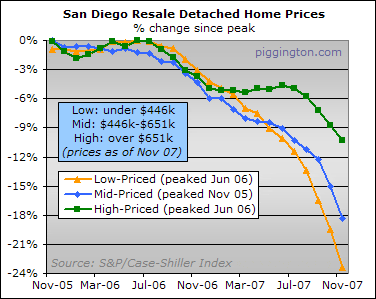
I thought the huge drops seen recently in the size-adjusted median were at least partially due to shifts in the composition of what buyers were buying (i.e., more cheap homes selling than before). But the latest HPI release, which measures repeat same-home sales and thus can’t be distorted by changes in what’s selling, indicates otherwise. The abrupt price drops appear to be the real deal.
As a matter of fact, my quick and dirty Case-Shiller predictor actually underestimated the drop. As you may recall from the December data rodeo, I thought that the 3-month average of the detached size-adjusted median might give us a rough idea of where the HPI was headed. To my surprise, given the suspected composition changes per the above paragraph, the HPI actually fared worse than predicted. The 3-month moving average of the detached size-adjusted median (I need to come up with a shorter name — let’s just call it the "HPI predictor" until I think of something better) fell by 2.4% in November, while the November HPI actually ended up down 3.4%.
The new predicted HPI is below — this will be updated for January upon the occasion of the next data rodeo:
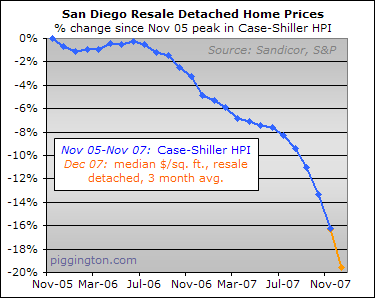
Alright, I think we’ve established that the HPI has dropped a lot. Here are some more graphs. First, the long-term version. As always, this shows that the high tier’s resilience has more to do with the fact that it never got so overvalued as the other tiers than anything else. It simply doesn’t have as far to fall.
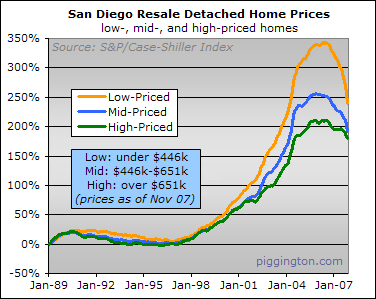
An here are the since-the-peak graph and the long-term graph adjusted for CPI inflation (note on the former that the inflation-adjusted peak is of course earlier than the nominal peak):
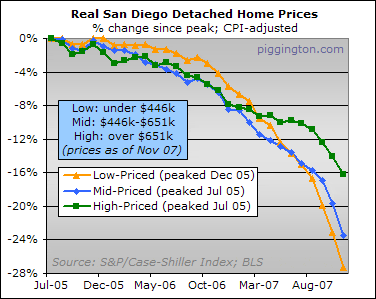
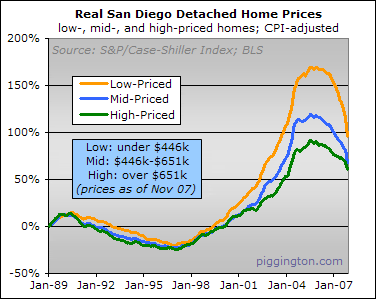
Not that this is any big news, but the decline has really picked up the pace. To put it in perspective, as of November the HPI was falling at an annualized rate of over 40%. (Not that I expect this rate to continue all year, this being the weak season and all, but still.) Or, home prices fell more in a single month than the permabulls thought they’d fall ever. Or, if you were to stack all the home equity dollars lost by the average household in November, you would have a stack, like, several feet high or something. You get the idea.

As always, a timely and
As always, a timely and comprehensive analysis. Thanks, Mr. Toscano.
November may be a slow month, but it sure does not look like that slowness manifested itself in price drops in earlier periods.
It will get much worse. Talk
It will get much worse. Talk to any bankers who have access to internal data and know, who are also willing to speak off the record.
Even if you know nothing about what’s going on behind the scenes at banks, the fact that public figures in the financial sector like Jim Cramer are telling people to walk away from their mortgage, and 60 Minutes airs an episode where borrowers state their willingness to walk away from homes they “CAN” afford to pay the mortgage on, but “WON’T” because they now feel like it’s throwing good money after bad, is a harbinger of catastrophic things to come.
As prices continue to fall,
As prices continue to fall, an increasing number of owners will owe more than their houses can be sold for, and it is likely that an increasing number of these owners will walk away from their homes, and the banks will sell them for big losses. It seems likely that as this snowballs, many banks will be overwhelmed with the losses and will fail. If this occurs, investors will go into panic mode, and runs on banks might even occur. I never seem to see articles dealing with this sequence of events. It seems likely to me that this will occur.
i think this government will
i think this government will do whatever it takes to prevent that from happening. be it a direct tax-cash input, a freeze/moratorium of some sort, armed barricades of atm’s…
i dont see any circumstances in which the government would allow any of the large banks to outright fail. the threat of japanese style recession is probably more palatable than great depression style depression.
It will get much worse. Talk
It will get much worse. Talk to any bankers who have access to internal data and know, who are also willing to speak off the record.
Even if you know nothing about what’s going on behind the scenes at banks, the fact that public figures in the financial sector like Jim Cramer are telling people to walk away from their mortgage, and 60 Minutes airs an episode where borrowers state their willingness to walk away from homes they “CAN” afford to pay the mortgage on, but “WON’T” because they now feel like it’s throwing good money after bad, is a harbinger of catastrophic things to come.
Great data…I have a
Great data…I have a question that may have been answered in some previous thread…Are the dollars representing the low, mid, and high priced homes as of the peak prices or todays prices? I would assume that those categories are for the peak price, which means some of the mid priced could now actually be in the low prices tier, but still be tracked under the mid peak? Or do they move that home into the low tier once it has become a low tier home? I am sure there is an expanation.
You should find your answer
You should find your answer here:
http://piggington.com/price_changes_in_low_mid_and_high_priced_homes
Here’s a quote from Rich a few posts down on that page:
“A home is put into a price tier based on its value as of Aug 2007. It won’t change categories no matter what its price changes are.”
That quote by Rich was
That quote by Rich was because he was considering the August data set, not because that is when the tiers were established.
The breaking of the sales into three tiers is confusing.
Every month’s home price data set is composed of sales during that period. Each sale has a prior sale. Houses are put into one of the thirds based on the first sale of that sale pair.
For example, a house sold in November ’07 and first re-sold (initial sales are excluded) in June ’04 is put into one of the tiers based on which tier the ’04 sale places it in. If it was a bottom third house in ’04, it would be a bottom third house in ’07 even if it is a top third house in ’07.
I believe the dollar levels of the tiers are as of the particular month’s data set.
The single tier is a lot
The single tier is a lot easier to follow but the three tier breakdown really does provide a better look at what’s happening. It’s especially useful when one of our trolls comes through citing an anecdote about one or two sales that don’t jibe with the averages.
Different market segments are moving at different paces.
———–
The slope on that curve is something else. I don’t recall any period where I’ve ever seen so much downward change all at once. The conventional wisdom was that prices would take longer to correct than they took to distort, but if this keeps we’re going to cover a lot of pricing territory in short order.
For the life of me I just can’t see this trend holding up. It’s got to moderate at some point and I would think that would happen sooner rather than later. When considering how long it’s going to take to get the rest of the foreclosures resulting from these ARMs in and out of the pipeline, the current price structure doesn’t have enough “gas” to bleed off to last the entire time.
Were this rate to hold up, an overcorrection that ran concurrent with the anticipated foreclosures would cut so deep we’d end up below the prices we started with in 1996.
Now I’m wondering if maybe it will bottom out quick and maybe just stay there for a while as the ARM reset schedule plays itself out. That would be a first.
We are all sort of
We are all sort of dumbstruck, I suppose. I keep on staring at my graphs of the data, trying to glean meaning from them. A couple more things I noticed:
Especially after the inflation adjustment, I see that, as steep as the downslope now is, it is not as steep as the upslope was. The hump is still asymmetrical. This sort of jibes with common sense that prices are stickier on the way down than up.
The other point is that the tiers have inverted behavior versus the late 80’s / early 90’s bubble. In that one, the mid and upper tiers fell further than the bottom tier. Possibly that is because the lower tiers were more inflated by new loans, e.g. subprime.
When you look at the graph you see how vastly larger this bubble was than the prior. Man is it gonna be a rough ride.
The hump is still
The hump is still asymmetrical. This sort of jibes with common sense that prices are stickier on the way down than up.
Good eye/comments. I love the three tier system. They really are three different markets, from several perspectives. The three graphs get more symetrical in descending value order is interesting too.
One other thing to think
One other thing to think about that might affect the speed of the downturn: real estate has never crashed since the internet became widespread. To me this is a VERY important difference because correct pricing is based on availability of accurate market information, and in this crash that information very easy to get. Previously you had to rely on your Realtor or the major news outlets.
That leads me back to a
That leads me back to a point I’ve been making on this board for a couple years. In the last 10 years we’ve made a lot of progress in making both the raw data and the analyses more readily available to anyone who chooses to look for it.
The housing markets will never operate off a completely rational basis but it could become more rational than it has been. Taken to its logical conclusion, the results of this trend would eventually curtail the degree to which these mood swings distort.
I’m looking to see how far this end of the cycle overcorrects. If it isn’t by much that would indicate to me that a lot more people are paying attention to the fundamentals and it might indicate to a generally more rational and stable market moving forward from there. If the cycle does grossly overcorrect I would interpret that as a sign that most people haven’t learned anything and have just been following the examples set by their friends and neighbors.
Bugs,
What makes you think
Bugs,
What makes you think the Internet will make people anymore rational on the way down than on the way up. Fear and greed are hardwired into the human psyche – not amount of information and analysis has ever or will ever change that. Information about the gross overvaluation of residential real estate and the open handed lending policies in force was easily had for the last 5 years. It didn’t seem to deter many people from buying. We have a debt-induced forced liquidation of assets underway – of course it will overshoot on the downside. When real estate becomes a truly hated asset and buying a house is universally viewed as a dumb idea, we will be at the bottom – that is the way bubbles end. I think we have a ways to go.
Brian,
I cannot disagree
Brian,
I cannot disagree with you about the folly of overestimating the general population’s capacity to be rational. I just couldn’t help but notice how much faster and more effectively the word spread about the changing market conditions this time as compared to last time.
I reckon I may just got have gotten a little too caught up in extrapolation.
“I just couldn’t help but
“I just couldn’t help but notice how much faster and more effectively the word spread about the changing market conditions this time as compared to last time.”
BINGO!
The last time we had a downturn, people came to believe and act on it so gradually that it had the effect of mitigating the damage. This time around it’s totally different!
Hey, that’s good news. Not
Hey, that’s good news. Not the falling prices, but the decompression in pricing. If you look at the the ’89-’07 charts, what is apparent is the compression in pricing. Low end more than tripled while the high end merely doubled.
That does reflect what we saw, good stuff got expensive, but it was pittance above offal. We see the floor falling out of the low end and it needs to. The spread between low end and high end needs to re-establish itself in order of the housing market to again create move-up equity and opportunity.
You look at the last chart and realize, while the high end has come down much less than the low end, the low end is still more inflated.
Like I commented on last
Like I commented on last month, but still wonder about is why are the tiers so close together in price? And are they really relevant in our area due to the fact that most homes are priced over $651K. Can someone explain to me how these tiers apply to our expensive markets?
Cashman
Active MLS listings
Cashman
Active MLS listings as of today;
up to 446k 4469 condos 5058 detached
446001 to 651k 826 condos 3896 detached
651001 up 810 condos 3811 detached
If you look at these numbers with the current combined median sales price in mind,which is in the ball park of the 446k number, you see the distribution of active listings is in line with that figure, around 9,000 properties above and 9,000 below.
Rustico, thanks for the
Rustico, thanks for the stats. I guess it’s just an illusion that when I search the LA Times every Sunday that most of the homes seem to be price well over the $651,000 level. Of course, I’m only looking at SFDs, which probably explains some of the perceived discrepancy. But you’re right, if you look at the median prices for LA or SD counties, I believe it’s in the mid 500’s, which would give credence to the C/S tiers. I’ve just been looking in the wrong neighborhoods, the one’s where people would actually want to live!
NSR,
Am I reading this
NSR,
Am I reading this wrong? It’s late but isn’t the relativity of pricing about the same for all tiers? By that I mean if a 661k house went up 200% it’s a 1.3 million dollar home and a 441k house going up 340% is about the same price is it not? Ditto for the mid-range prices. It basically comes back to the old “you get what you pay for on the premium stuff” and the herds way overpaying for lower-quality homes. A 340 % increase of an expensive home (850-900k) would have put it in rarefied territory. Let’s face it – the average home price was significantly higher than the ranges listed so we’re talking some outrageous numbers at some point. There were many successful flippers and many more liar-loan fools that played the move-up game. When the high range price drops to 25% from peak you’re talking 40% and 50 % drops for the other two.
I see that happening easily within six months with the amount of inventory already out there and a plethora of re-sets on the way. Sandiegobanker1’s comments about internal data confirms what I’ve been hearing from people in the biz. The banks are taking a hit again today because of more defaults on credit cards and other loans. They are not in the homeowner business and can’t afford to carry their inventories for much longer. What can the gov’t possibly do to stop the inevitable? We’re looking at a 3 TRILLION dollar budget and record deficit on the table. They won’t touch the military funds even though a large portion of that money would be better served within the country. We’re going to see a recession and depression of major proportions it appears. Let’s just hope the euro doesn’t become the currency of choice.